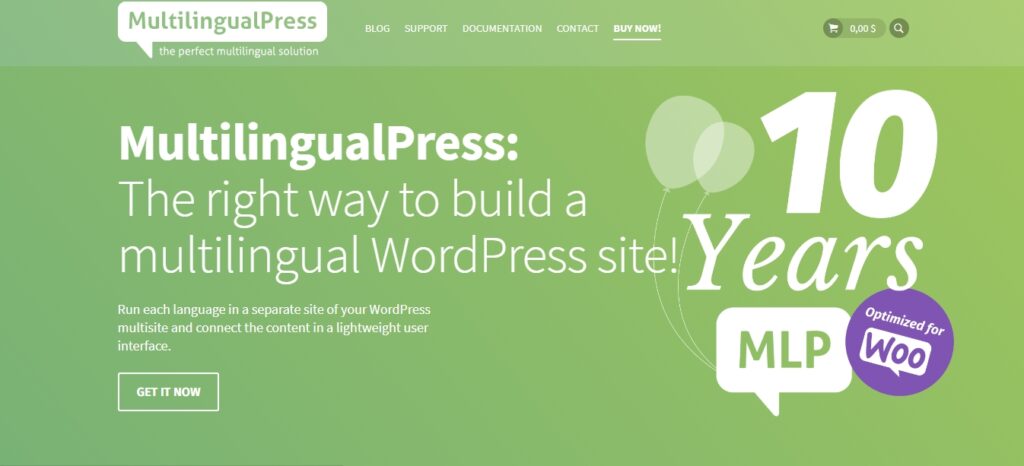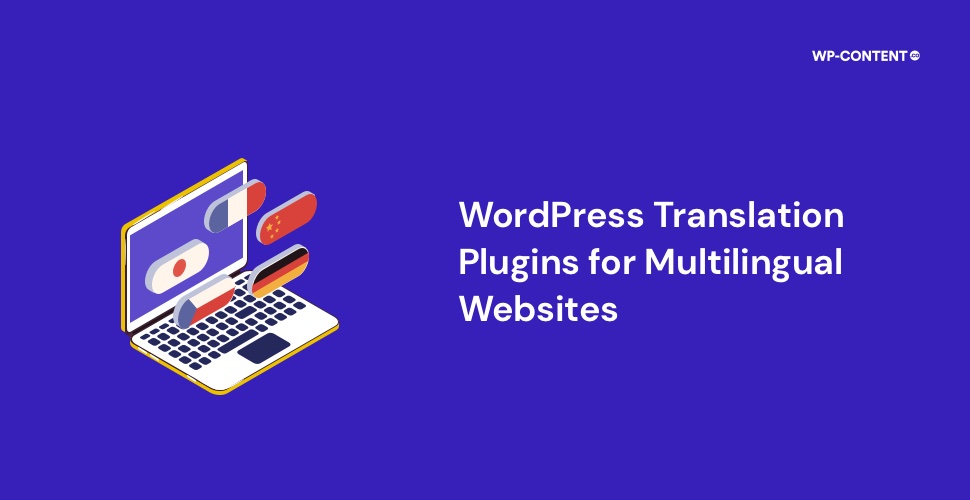Language should never be a barrier. Be it for a human to human communication or on the internet. Our WordPress websites, themes or plugins should never be limited by the language barrier. Having the website contents and other elements translated into multiple languages is always beneficial. WordPress doesn’t natively offer any translation feature and therefore the only way to translate our website is with the help of WordPress translation Plugins. No matter how good the content is, if it is not translated into different languages, then we are missing out on a lot.
The Advantages of Translating WordPress Websites, Themes and Plugins
Having the website contents translated opens up an entirely new world. The most important benefits of having a translated WordPress website or products are:
- Reach a Wider Audience – People are always looking for new information on all sorts of topics. Imagine this scenario – your website provides the needed information in a clear cut way. But the analytics shows very few people accessing the website. The reason is the language limitation. The content is available only in a single language. We cannot expect users around the world to know the language that we have used or the English language, which is the most widely used language on the web. Some users still prefer to view the contents in their native language. So, having the contents translated into multiple languages would help in reaching a wider audience and more website traffic. The same applies to themes and plugins also.
- SEO Optimization– Ranking high on the SERP is always desired. If you have a translated WordPress website then the chances of being ranked in the first two pages are high. Since the majority of the website contents are written in the English language, the competition is high. But if the website is translated into multiple languages, it boosts the SEO opportunities. Better SEO results lead to more site traffic and more recognition. The higher SERP rankings also boost sales and revenue with the incoming of more traffic.
- Create a rapport – Having a multilingual website would let the users know that one has spent enough time researching the market, culture and audience. Translating the website contents into different languages will allow us to act as a credible source, which in turn leads to more online traffic.
Also read: Best AMP WordPress Plugins
What Exactly is a WordPress Translation Plugin?
Well to put it simply, WordPress Translation Plugins enable us to translate the contents of our website, themes and plugins into multiple languages. This would allow the user to view the contents in their preferred language and thereby increasing the accessibility and leading to a wider reach. Now, we know what are translation plugins, what they do and how we can use them to our advantage.
There are mainly two types of translation plugins, Automatic and Manual Plugins. The Automatic plugin would do the translation all by itself, without any external input. The automatic WordPress translation plugins make use of the Google Translation API and other available translation APIs. However, the translation done by the automatic translation plugins is not error-free. From time to time errors do happen. But they are improving after each update.
The second category is the Manual WordPress Translation plugins and as the name suggests we have to manually do the process. This provides the most accurate translation but is time-consuming and an arduous task. With manual translation plugins, one has to hire one or multiple translators to get the job done most of the time. We will cover both automatic and manual WordPress translation plugins today.
Also read: WordPress Accessibility Plugins That You Should Consider
The Top 8 WordPress Translation Plugins
1. Translate WordPress with GTranslate
Translate WordPress with GTranslate is a translation plugin for WordPress that supports both manual and automatic translation features. This WordPress translation plugin supports over 100 languages and comes in both free and premium versions. The plugin can translate all the contents on a website, be it posts, pages, widgets, buttons and so on. The free version does support all languages but is limited in certain features like we cannot edit the translated content. The plugin offers the ability to choose the language from a drop-down menu. The plugin uses Google’s Translate API. The plugin would allow the website visitors to choose which language they want to view on the website page. The price for the paid version starts from $9.99/month.
Pros:
- One can include as many languages as one needs.
- Able to translate both AMP and Non-AMP pages.
- Analytics integration builtin.
Cons:
- The only way to index the translated WordPress website is to buy the premium versions.
- No URL translation feature for SEO optimization in the free version.
- Only paid versions allow translations from the front end.
- URL and slug translations are only available with the paid versions.
- Manual edit of automatic translation is only available with the premium plans.
2. WPML
WPML, which stands for WordPress Multilingual, is one such WordPress translation plugin that is only available in the premium option. The plugin is not available on the WordPress plugin repository, one has to get it directly from the developer’s website and upload it manually. The plugin can translate everything from themes, plugins, menus, etc. WPML is also compatible with WooCommerce websites and doesn’t cause any compatibility issues. The Woocommerce plugin is available from the WordPress plugin repository, but one must already have a registered WPML account to use it.
There are three ways to translate content with this plugin. The first is automatic translation- which integrates to either Microsoft Azure, Goggle Translate or DeepL. The user can decide which service to integrate and can change at any time. The second method is to translate the content manually, which we all know will take a lot of time. The third method is to take up the assistance of professional translation services, as the plugin does allow to connect to external translation services.
Pros:
- Support for WooCommerce
- Can translate all the contents.
- Integration with external translation service providers.
- SEO optimization as the plugin can be combined with the Yoast SEO plugin.
Cons:
- No free version.
- Comes only with 65 pre-configured languages. For more languages, we must add them manually.
- WPML uses a credit system in place for automatic translation, which means one has to pay extra if the allotted credit is exceeded. The standard allotment is 2000 credits/month.
- Integration with external translation service providers is an add on service that needs extra payment.
3. Google Website Translator
Google Website Translator plugin for WordPress developed by Prisna, draws its powers from Google Translate API to provide the translation service. The plugin supports over 100 languages and is completely free to use. The plugin only supports automatic translation for the WordPress website. Install the plugin and manually choose which all languages to translate to. The plugin can translate themes defaults, contents and so on. There is no limit to how many words can be translated. There is also a paid version of the plugin, with a one-time fee of 50$, that offers lifetime support and updates.
Pros:
- Doesn’t affect page loading speed.
- No limit on the number of words that can be translated.
- Can be used as a widget or as a shortcode.
- Automatic translations can be edited.
Cons:
- Only the premium version supports translation for permalinks, sitemap and indexing the pages on search engines.
Also read: Best WordPress Migration Plugins to Move Your Site
4. Multilingual Press

Multilingual Press translation plugin operates differently. It makes use of the WordPress Multisite functionality. Multilingual Press does not offer an automatic translation service. For every language we choose, the plugin creates a different WordPress multisite. From the dashboard, one can connect to all those sites in a seamless manner. This plugin is beneficial for those who want to add additional content in a new language without changing the main page. Thereby one can focus on content that is specific to the concerned place. Moreover, it is beneficial for SEO purposes, as translated manually, one can optimize the new multisite with the SEO keywords. The translated multisite won’t disappear or go off the grid, even if the plugin is disabled.
Pros:
- Best for SEO optimisation as search engines would be able to index the new translated WordPress multisite.
- The plugin supports over 800 languages.
- Works well with WooCommerce websites.
- Compatible with Elementor.
- The plugin can sync with the Yoast Seo plugin.
- The plugin would automatically redirect all the visitors to the desired language multisite based on their browser language setting.
Cons:
- No free version. We have to download and upload the plugin.
- No automatic translation service.
- Pricing is on the expensive side.
- The plugin will feel complicated for WordPress beginners due to the multisite concept.
- Even with the highest plan, one can only translate the website to 18 different languages.
5. TranslatePress
TranslatePress is a WordPress translation plugin that allows us to do the translation process from the front end and also provides a live view of the changes. The plugin mimics the workings of a page builder. With the ability to see the changes in real-time, one can make sure how the translated content would look to the website users. This plugin supports both manual and automatic translations. For automatic translation, the plugin uses Google Translate API.
The majority of the features are available in the free version. With the paid version, we can add extensions and other premium features. With the free version, one is limited to only one language, that is one can make the website bilingual, not multilingual. The premium version provides support for multilingual SEO and many more. The free version is enough to make the WordPress website bilingual. But for adding more languages one must go with the paid version. All the translation data are stored in our own database and not outside.
Pros:
- Supports over 200 languages.
- Offers a live view of the translation, in real-time.
- Files are stored in our database.
- Compatible with WooCommerce.
- Gutenberg compatible.
- Able to translate themes, plugins, and other content like blog posts, forms, etc.
Cons:
- With the free version, we can only translate the WordPress website into one language.
- For SEO features, one must switch to the premium version.
- Pricing is on the higher side.
- No feature to add translator accounts in the free version.
6. Weglot

Weglot is another fully paid WordPress translation plugin. The plugin is available on the WordPress repository, but one needs to signup with them to use all the functionalities. The plugin from the repository is needed to connect to the full Weglot services. Weglot also provides three methods to translate, automatic, manual and professional translation services from them which is an addon option, hence will be chargeable.
Pros:
- Multilingual-SEO friendly.
- Metadata and alt text can also be translated.
- Supports over 100 languages.
- Integrates with Azure, Google API and DeepL and Yandex.
- Can be used as a widget or shortcode.
- Provides a visual editor for a live view.
Cons:
- Premium plans are on a monthly and yearly basis. No one-time purchase plan.
- External Professional Translation services will cost extra, other than the price plan.
7. Polylang
Polylang translation plugin for WordPress offers a free version as well as a paid version. Polylang is a manual translation plugin, where we have to feed the translated content ourselves. The plugin also supports WooCommerce, but only for pro users.
Pros:
- Best suited for manual translations.
- Lightweight plugin.
- WPML API compatible.
- The free version has no usage restrictions.
- Comes with 90 predefined languages.
Cons:
- Automatic translation is only available with the addition of an extra plugin.
- The free version cannot translate URL slug.
- No REST API support in the free version.
- The plugin works with the majority of the themes and plugins out there, cannot guarantee it will work with all the themes and plugins.
- The WooCommerce plugin is separate.
Also read: Best Multi-Currency Plugins for WooCommerce
8. Loco Translate
Loco Translate is a plugin that is used to translate themes and plugins. Hence it is mainly useful for developers. It offers seamless integration with DeepL, Google, Microsoft and Yandex. Loco Translate allows support for both PO (Portable Object) and MO (Machine Object) files. The free version allows up to 2000 translations and 10 languages. Once this limit has been reached, one has to switch to any one of their premium plans.
By default Loco Translate only supports manual translation. Automatic translation can be added by registering with a translation service provider and entering the API key in the plugin settings menu. The supported translation services are DeepL, Google Translate, Microsoft Translator, and Lecto AI. Automatic translation prices will depend on the service provider.
Pros:
- Supports both PO and MO files.
- The plugin comes with WordPress locale codes inbuilt.
- Allows us to work directly from the WordPress dashboard.
- Best to translate themes and plugins.
Cons:
- The plugin doesn’t automatically update changes that happen with new updates. So, one has to manually edit the plugins and themes after new updates.
- Premium plans come with a monthly charge.
Wrapping up
Translating the WordPress website to either multilingual or bilingual is always preferred. Mainly because it boosts the SEO opportunities and outcomes. Apart from great SEO results, it will help us to reach a wider audience across the globe, as we are not limited by the language barrier. One can choose either to go with the free plugins or opt for the paid version if certain features are needed. The choice of which plugin to use will eventually come to personal preferences. One must keep in mind that not all WordPress themes and plugins can be translated. Remember to make a backup, to roll back changes if anything goes wrong.
Disclosure: This post may contain affiliate links, which means we may receive a commission if you click a link and purchase something that we shared. Read more about Affiliate disclosure here.








